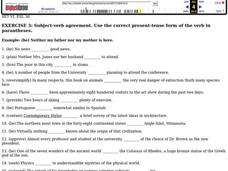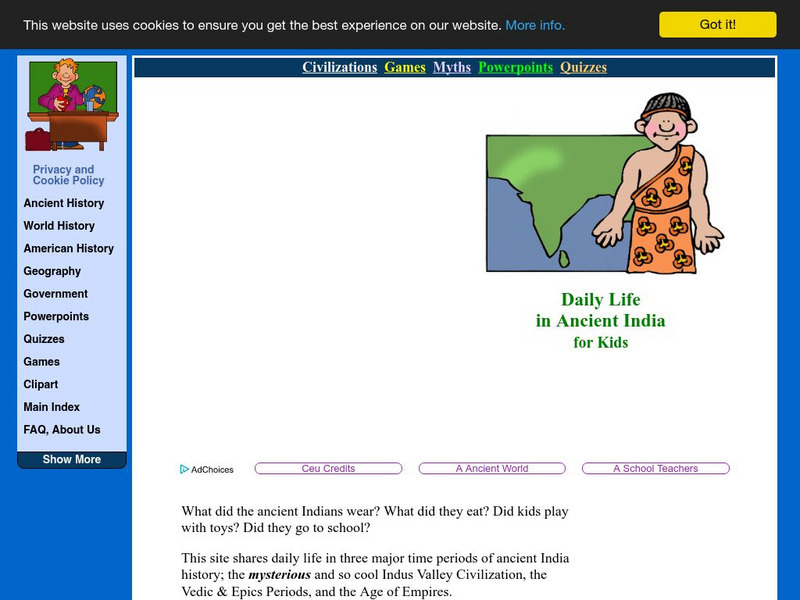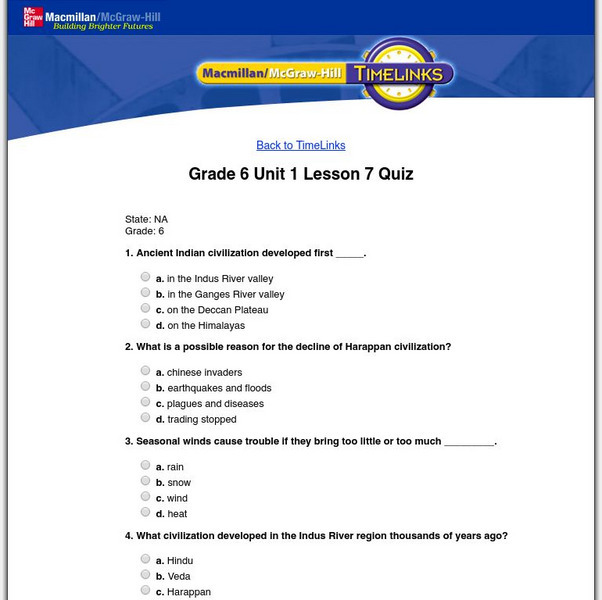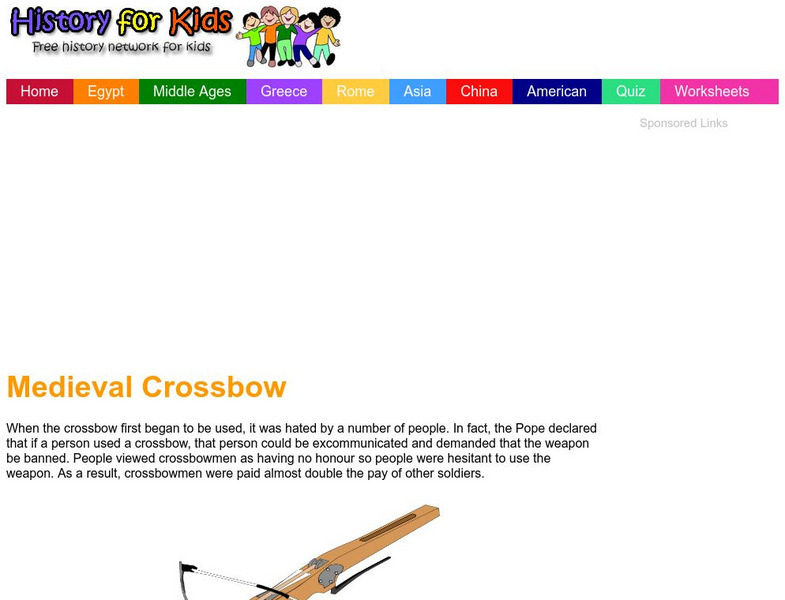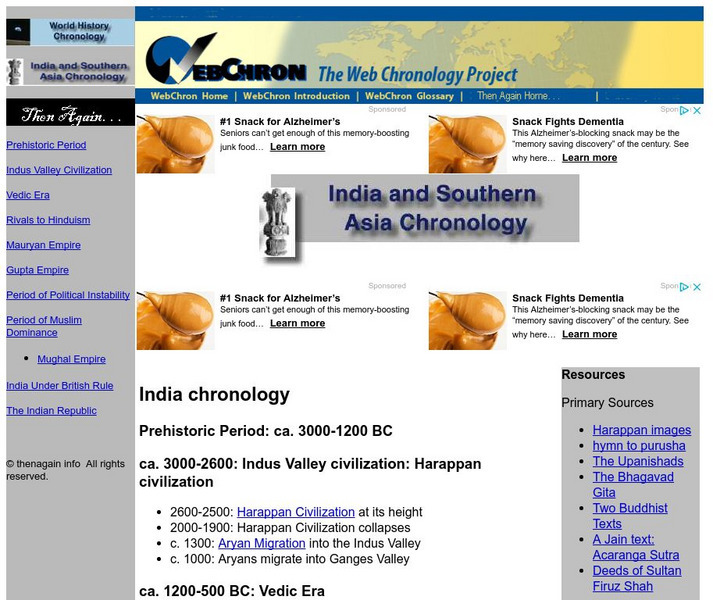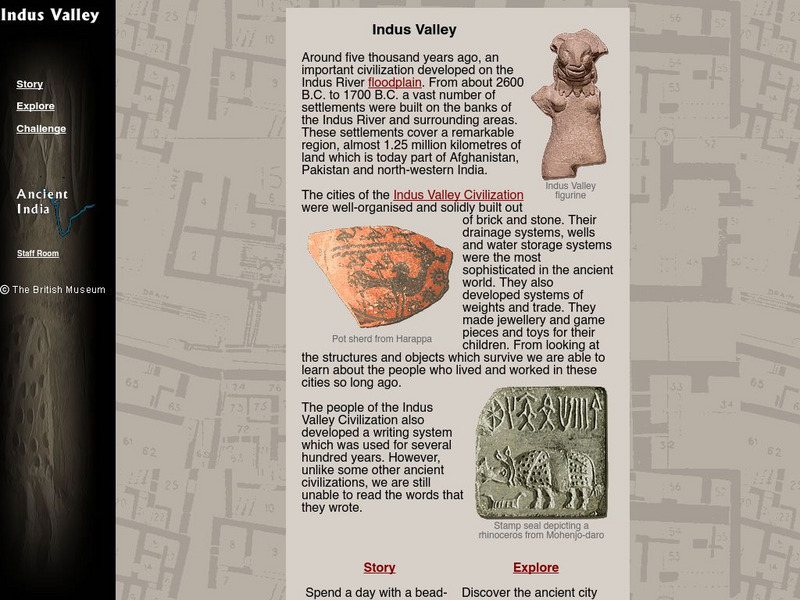Curated OER
Seventh Grade Social Studies Test
In this Georgia social studies assessment worksheet, 7th graders respond to thirty multiple choice questions based on seventh grade social studies skills.
Curated OER
The Four Corners Region of the United States Cultures, Ruins and Landmarks
Students who live in the inner city are introduced to the four corners region of the United States. In groups, they examine how the region differs compared to where they live and their culture. They develop maps of the area and locate...
Curated OER
Subject-Verb Agreement
In this grammar learning exercise, students use the correct present -tense form of the verb in parentheses that makes twenty sentences grammatically correct.
Curated OER
Subject-Verb Agreement
In this grammar worksheet, students choose and underline the appropriate present-tense form of the verb in parentheses in twenty sentences that makes each one grammatically correct.
Curated OER
Utah Archaeology
Students study past cultures of those who made areas of Utah their home by exploring the artifacts these cultures left behind. Students will explore different types of fossils and learn that fossils are evidences of past life.
Curated OER
Saris, Kimonos, Tagas and Smocks: Exploring Clothing Across Cultures
Students explore via the internet all types of clothing around the world. Students discuss that the way people dress is an important means of expressing identity. Students collaborate via Internet research the social purposes of clothing.
Curated OER
Babylonian Square Roots
Learners are introduced to a method for finding square roots used by the Babylonian people of Mesopotamia. The method involves dividing and averaging, over and over, to find a more accurate solution with each repeat of the process.
Curated OER
Utah Archaeology
Students use Play-dough explore different types of fossils and examine how fossils are evidences of past life.
Curated OER
POWERFUL POTATO
Students will observe the growth process of a potato plant.Plant a potato in a large clay pot or gallon bucket. You may purchase seed potatoes
from a seed outlet in early spring or use a potato from home that has started to sprout. Make...
Curated OER
Lesson 4: A Field Trip to the Maine State Museum
Young scholars analyze the Maine State Museum's exhibit 12,000 Years in Maine. They create an artifact and write a description of that artifact that demonstrates their understanding of the way technology shapes culture.
Stephen Byrne
History for Kids: Ancient Indian Religion
Reference article provides an overview of the ancient religions of India, including information on Hinduism, Buddhism, and Jainism.
Stephen Byrne
History for Kids: Ancient Indian Art
Reference material on the art of ancient India talks about the mysteries and religious symbolism embedded in the art and architecture of ancient river valley civilization.
Lin and Don Donn
Lin and Don Donn: Daily Life in Ancient India
This site from Lin and Don Donn shares daily life in three major time periods of ancient Indian history. The periods referenced are the Indus Valley Civilization, the Vedic and Epics Periods, and the Age of Empires. This site is designed...
Curated OER
Macmillan/mc Graw Hill: The World: V. 1: Rivers and Civilizations: Lesson 7 Quiz
A short quiz on ancient India.
Stephen Byrne
History for Kids: Daily Life in Ancient India
History overview of what daily life in Ancient India was like. The author talks about the clothing, children's games and some of the history of India beginning with the Harappa and Mohenjo-Daro civilizations.
Cosmo Learning
Cosmo Learning: World Civilization Since 1500
Twenty-four college video lectures provides an overview of the interactions among seven major cultural traditions (Judeo-Christian, Graeco-Roman, Indian, Chinese, African, Islamic, American Indian), from c.e. 1500.
Other
Ken Farshtey: Change From River Valleys to Classic Civilizations [Pdf]
This slide presentation provides an in-depth look at the Indian, Chinese and Mediterranean world's development from river valleys into classic civilizations. Early river valleys and classic civilizations are described on a broad spectrum...
Stephen Byrne
History for Kids: Indian Science
History for Kids teaches about the scientific achievements of the ancient Indus Valley civilizations, the Harappa and Mohenjo-Daro. With links to teacher materials.
Houghton Mifflin Harcourt
Harcourt: School Publishers: Taino Indian City Found
Read about a Taino Indian city discovered in the Dominican Republic. Includes two discussion questions you can use to check reading comprehension. Bilingual Spanish/English.
Smithsonian Institution
National Museum of Natural History: Unmasking the Maya: Story of Sna Jtz'ibajom
This Smithsonian website looks at the Maya of today in the Chiapas region of Mexico with a brief overview of their history.
Then Again
Then Again: Web Chron: India and Southern Asia
On his website, a history professor provides a brief timeline of the history of India and Southeast Asia. Key words in each entry are highlighted as links for additional specific information and pictures. Link takes you to the index...
American Indian Heritage Foundation
Mayan Civilization
This site describes the geography and landscape of the areas once inhabited by the Mayas. There is also information on Mayan writing, literature, culture, political organization, Mayan art, and other information on the Mayan Civilization.
Other
Simon Frasier University: A Journey to a New Land
This interactive site examines questions about early human migration to North America offers grade-level appropriate information for primary, elementary, middle, secondary and post-secondary levels. Teacher resources, simulations, video,...
The British Museum
The British Museum: Indus Valley
This interactive site offers students an online glossary, as well as a game of matching pieces of pottery, spending the day with the maker's son, and exploring the ancient city of Mohenjo-daro.





